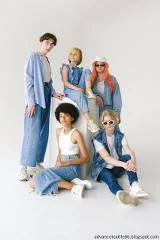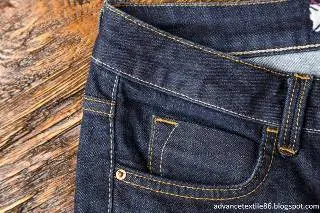Denim
Denim is a strong cotton warp-face textile where the weft runs under two or more warp yarns. This twill weave creates a diagonal ribbon that separates it from the cotton duck. Although a denim predecessor known as dungaree was produced in India for hundreds of years, denim itself was first produced in the French city of Nemes in Serge de Nemes.
At
present most of the denim produced
is made with a shuttle loom that makes fabric bolts 60 inches or wider, but
some denim is still woven into
conventional shuttle looms that typically produce a bolt 30 inches wide.
Shuttle-loom-woven denim is usually recognizable by its selvage, the edge of
the fabric made as a continuous cross-yarn flips the side at the edge of the
shuttle loom. The selvage is traditionally raised by one or more contrasting
colored warp threads that can serve as identifying marks.
Characteristics of denim
i.
Denim is one of the most demanding international commercial woven coarser
fabrics
ii.
Produced by 100% cotton yarn but you will find that there are a few denim fabrics mixed with spandex and polyester.
iii.
It is made by twill weave.
iv.
Warp yarn dyed by indigo dyes
v.
The left yarn remains white/gray as its natural color
vi.
Denim jeans are very strong and do not tear easily because it is long-lasting.
vii.
It can be ironed at a high temperature
viii.
It is a very durable fabric but after a certain time it fades
ix.
It is durable, open, and temperamental
x.
It is a woven fabric that is made of warp and weft yarn
xi.
To control shrinkage, and wrinkling generally blended with spandex
xii.
The mixed denim fabric has very good extensibility and is comfortable to wear for a slim
figure.
xiii.
Uses of Denim: Jackets, Jeans, Shirts, Skirts, Swimsuits, Belts, Handbags, etc.
Different types of denim
i.
Raw denim
ii.
Sanforized denim
iii.
Stretch denim
iv.
Crushed denim
v.
Selvage denim
vi.
Acid wash denim
vii.
Poly denim
viii.100%
cotton denim
ix.
Colored denim
x.
Waxed reverse denim
xi.
Ecru denim
xii.
Thermo denim
xiii.
Bubblegum denim
xiv.
Bull denim
xv.
Slub denim
xvi.
Vintage denim
xvii.
Reverse denim
xviii.
Stonewash denim
xix.
Dual ring-spun denim
xx.
Natural denim
xxi.
Open-end denim
xxii.
over twisted denim
xxiii.
Printed denim
xxiv.
Ramie cotton denim
Describe different types of denim
Raw denim
Raw
denim is the term for denim fabric that is washable and unrefined. Most of the
jeans sold today are produced through washing and troublesome denim to create
an artificially worn look. Jeans from unbranded brands are not always raw,
never miserable. We like raw denim for a variety of reasons but our favorite
reason is how nicely it will fade. Raw denim will fade naturally over time,
just wear it as long as you can before washing your raw jeans, beat them, and
wear ‘em hard’ and soon you will have a nice and personalized naturally faded
pair.
Sanforized denim
Sanforized
denim is made from fabric that has been stretched, stabilized, and shrunk to
the width of the mill. The amount of compression may decrease after the first
wash of your jeans. In fact, it is a patented process of treating denim and
cotton fabrics before removing many of the natural shrinkage of the jeans,
such as when you buy jeans, wear them and then wash them later as they will
shrink less than 1%. Washes can shrink up to 10% and shrink for about three
washes. The denim fabric is held through a sanforizing machine, wet and heated
with water or steam to compress it across rubber belts and drums, and then
allowed to dry and compact, and loosen in shape.
Stretch denim
Stretch denim is a relatively new type of denim cotton that incorporates small amounts of elastane, a stretchy, synthetic fiber into the fabric. Stretch jeans usually contain one to three percent elastane. Stretch Jeans Style jeans made with stretch denim fabric. Jeans made with stretch denim material may look like regular jeans but provide more flexibility and “give” the wearer’s body movement. Stretch jeans are also usually form-fitting than jeans made without any stretch of the fabric.
This
is a special kind of look that ensures that the denim appears permanently
wrinkled. This finish is achieved by weaving with an over-twisted weft yarn.
The fabric is washed so that it shrinks, enhancing the effect. Crushed denim is
treated as a wrinkled or crumpled appearance. It is often used in conjunction
with other processes such as acid or stone washing to give a truly worn look.
These wrinkles will not come out to wash.
Selvage denim
Selvage
denim is woven using old-fashioned denim-weaving techniques; Woven into old
looms for maximum authenticity. Selvage looms were popular in denim weaving
from the mid-1900s to the end. U.S. denim mills began modernizing their
production at a rapid pace as the global demand for denim increased. It features
narrow, tightly woven bands on both ends of the denim fabric which, one,
prevents it from unraveling and, two, shows a clean finished look. The word
salvage comes from "self-edge", as the edge of the denim has a clean
finish and comes in a 32 "roll instead of the standard 62" roll.
Acid wash denim
The
process of acid wash jeans uses chemicals, splashes the color of the top
layer, exposing the white fabric. The color remains in the lower layers of the
material giving it a faded look. Acid washing can be done as a whole or made to
look splotchy.
Poly denim
The term "poly denim" is
widely used to refer to denim products that are made from a combination of
cotton, polyester, and other synthetic fibers. In addition to polyester,
lyocell and nylon materials are sometimes added to cotton to make denim
products. Some purists would say that poly denim is not "real" denim.
It has the advantages of being strong, durable, and even in appearance. The
polyester yarn used in this type of denim can be dull or bright depending on
the style of the final product. Poly-denim
blends look like dryer denim and is lighter in weight, which makes them more
convenient to wash and dry and more resistant to wrinkle resistance.
Vintage Denim
Vintage denim is a durable, rugged cotton twill
fabric that is most commonly used in jeans, jackets, and overall as well as
other types of clothing. Solid 100%
cotton heavyweight denim with vertical striking. Dry and stiff
hands/feeling. Suitable for slacks and jackets. It can also be used for home
decoration and crafts. The change from 100% cotton to elastic denim has been a dramatic change. You can only wear jeans made with elastane for a year or so
because elastane wears quickly and does not hold. It doesn't take 20 years for
these jeans to become vintage.












0 Comments